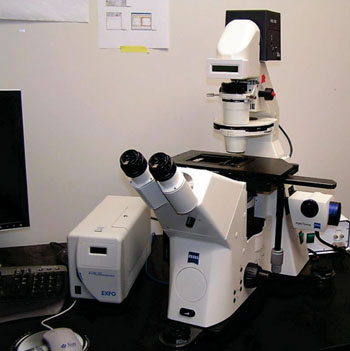Biomarker Identified for Basal-Like Breast Cancer
|
By LabMedica International staff writers Posted on 11 Aug 2015 |

Image: The Zeiss Axiovert 200M inverted microscope (Photo courtesy of Michigan Technological University).
Basal-like breast cancer (BLBC) is an aggressive form of breast cancer and is often referred to as triple negative, which means it is not responsive to the common medical therapeutics, and is more likely to metastasize.
Interleukins (IL) comprise a superfamily of pleiotropically acting cytokines that are present in the tumor microenvironment and are implicated in a wide variety of immunomodulatory functions, including cell maturation, proliferation, migration, and adhesion.
Scientists at the Boston University Medical Center (Boston, MA, USA) working in conjunction with those at the University of Cyprus (Nicosia, Cyprus) compared the markers on the surface of the cancer cells to gene expression profile of breast tumors deposited by scientists in international public databases. An unbiased approach using gene expression profiling of a BLBC progression model and in silico leveraging of pre-existing tumor transcriptomes were used to uncover metastasis-promoting genes.
The investigators used various techniques including breast cell cultures; gene expression microarray analysis was followed by in vitro validation and cell migration assays to elucidate the downstream molecular pathways involved in this process. Chemotaxis migration assays were performed and counted by using an Axiovert 200M inverted microscope (Carl Zeiss; Oberkochen, Germany). Real-time polymerase chain reaction (PCR), Western blots and immunological assays were also performed.
The scientists found that a molecule named Interleukin-13 receptor subunit alpha-2 (IL13Rα2) was abundant in metastatic or late-stage BLBC. When they looked at publically available data on patients, they were able to predict the likelihood of progression-free survival based on whether the cancer cells had high levels of IL13Rα2. The group also discovered that a subtype of BLBC that tended to spread to the lungs quickly had high IL13Rα2 levels. High levels of Signal transducer and activator of transcription 6 (STAT6) and Tumor protein p63 (TP63) expression were associated with longer distant metastasis-free survival of patients with breast cancer.
Sam Thiagalingam, PhD, associate professor of genetics and genomics, and coauthor of the study, said, “This discovery offers a glimmer of hope for patients stricken with BLBC. Personalized cancer therapies could be developed by targeting breast cancer cells that express copious levels of IL13Rα2.” The study was published on July 27, 2015, in the journal Breast Cancer Research.
Related Links:
Boston University Medical Center
University of Cyprus
Carl Zeiss
Interleukins (IL) comprise a superfamily of pleiotropically acting cytokines that are present in the tumor microenvironment and are implicated in a wide variety of immunomodulatory functions, including cell maturation, proliferation, migration, and adhesion.
Scientists at the Boston University Medical Center (Boston, MA, USA) working in conjunction with those at the University of Cyprus (Nicosia, Cyprus) compared the markers on the surface of the cancer cells to gene expression profile of breast tumors deposited by scientists in international public databases. An unbiased approach using gene expression profiling of a BLBC progression model and in silico leveraging of pre-existing tumor transcriptomes were used to uncover metastasis-promoting genes.
The investigators used various techniques including breast cell cultures; gene expression microarray analysis was followed by in vitro validation and cell migration assays to elucidate the downstream molecular pathways involved in this process. Chemotaxis migration assays were performed and counted by using an Axiovert 200M inverted microscope (Carl Zeiss; Oberkochen, Germany). Real-time polymerase chain reaction (PCR), Western blots and immunological assays were also performed.
The scientists found that a molecule named Interleukin-13 receptor subunit alpha-2 (IL13Rα2) was abundant in metastatic or late-stage BLBC. When they looked at publically available data on patients, they were able to predict the likelihood of progression-free survival based on whether the cancer cells had high levels of IL13Rα2. The group also discovered that a subtype of BLBC that tended to spread to the lungs quickly had high IL13Rα2 levels. High levels of Signal transducer and activator of transcription 6 (STAT6) and Tumor protein p63 (TP63) expression were associated with longer distant metastasis-free survival of patients with breast cancer.
Sam Thiagalingam, PhD, associate professor of genetics and genomics, and coauthor of the study, said, “This discovery offers a glimmer of hope for patients stricken with BLBC. Personalized cancer therapies could be developed by targeting breast cancer cells that express copious levels of IL13Rα2.” The study was published on July 27, 2015, in the journal Breast Cancer Research.
Related Links:
Boston University Medical Center
University of Cyprus
Carl Zeiss
Latest Immunology News
- Computational Tool Predicts Immunotherapy Outcomes for Metastatic Breast Cancer Patients
- Biomarker Could Predict Immunotherapy Response in Liver Cancer
- Epigenetic Test Could Determine Efficacy of New Immunotherapy Treatments Against Multiple Myeloma
- Blood Test Predicts Survival in Liver Cancer Patients
- Simple Blood Test Identifies Multiple Myeloma Patients Likely to Benefit from CAR-T Immunotherapy
- Portable Device Analyzes White Blood Cell Activity to Monitor Cancer Patients’ Health
- New Test Detects Return of Blood Cancer a Year Earlier
- Universal Blood Test Could Predict Organ Transplant Outcomes with Unprecedented Accuracy
- AI Tool Predicts Cancer Patients’ Response to Immunotherapy
- Molecular Profiling Improves Diagnosis for Children with High Risk Cancers
- Blood Test Measures Immune Response to Epstein-Barr Virus in MS Patients
- AI Predicts Tumor-Killing Cells with High Accuracy
- Diagnostic Blood Test for Cellular Rejection after Organ Transplant Could Replace Surgical Biopsies
- AI Tool Precisely Matches Cancer Drugs to Patients Using Information from Each Tumor Cell
- Genetic Testing Combined With Personalized Drug Screening On Tumor Samples to Revolutionize Cancer Treatment
- Testing Method Could Help More Patients Receive Right Cancer Treatment
Channels
Clinical Chemistry
view channel.jpg)
POC Saliva Testing Device Predicts Heart Failure in 15 Minutes
Heart failure is a serious condition where the heart muscle is unable to pump sufficient oxygen-rich blood throughout the body. It ranks as a major cause of death globally and is particularly fatal for... Read more
Screening Tool Detects Multiple Health Conditions from Single Blood Drop
Infrared spectroscopy, a method using infrared light to study the molecular composition of substances, has been a foundational tool in chemistry for decades, functioning similarly to a molecular fingerprinting... Read more
Integrated Chemistry and Immunoassay Analyzer with Extensive Assay Menu Offers Flexibility, Scalability and Data Commutability
As global healthcare systems increasingly shift towards networked laboratory operational models to enhance efficiency and patient access, there is a greater need for innovative solutions tailored to the... Read moreMolecular Diagnostics
view channel
Respiratory Panel to Help Clinicians Make Precise Treatment Decisions in Outpatient Settings
Respiratory tract infections are the primary reason for visits to emergency departments and subsequent hospitalizations. In the U.S., it is estimated that there are up to 41 million cases of influenza... Read more
Integrating Cardiovascular Risk Biomarkers Aids in Detection of ‘Inflammaging’
Cardiovascular diseases (CVD) continue to be the leading cause of death globally, responsible for nearly one-third of all fatalities worldwide. Traditionally, risk assessment for CVD has focused on well-established... Read more
Genetic Signature in Newborns Predicts Neonatal Sepsis Before Symptoms Appear
Neonatal sepsis, which occurs due to the body’s abnormal response to severe infection within the first 28 days of life, results in approximately 200,000 deaths globally each year. This condition affects around 1.... Read more.jpeg)
Integrating Multiple Protein Markers Predicts Health Outcomes in Chronic Kidney Disease Patients
Previous attempts to discover novel kidney biomarkers as risk factors for chronic kidney disease (CKD) progression have generally focused on evaluating proteins individually, which limits their prognostic... Read moreHematology
view channel
Next Gen CBC and Sepsis Diagnostic System Targets Faster, Earlier, Easier Results
Every hour is critical in protecting patients from infections, yet there are currently limited tools to assist in early diagnosis before patients reach a hospital. The complete blood count (CBC) is a common... Read more
Newly Discovered Blood Group System to Help Identify and Treat Rare Patients
The AnWj blood group antigen, a surface marker discovered in 1972, has remained a mystery regarding its genetic origin—until now. The most common cause of being AnWj-negative is linked to hematological... Read more
Blood Platelet Score Detects Previously Unmeasured Risk of Heart Attack and Stroke
Platelets, which are cell fragments circulating in the blood, play a critical role in clot formation to stop bleeding. However, in some individuals, platelets can become "hyperreactive," leading to excessive... Read moreMicrobiology
view channel
High-Accuracy Bedside Test to Diagnose Periprosthetic Joint Infection in Five Minutes
Periprosthetic joint infection (PJI) represents a significant global issue that is worsening as the number of joint replacements increases due to aging populations. In the United States alone, the anticipated... Read more_1.jpg)
Innovative Diagnostic Approach for Bacterial Infections to Enable Faster and Effective Treatment
For patients with bacterial infections, timely treatment with the appropriate antibiotics significantly improves their chances of recovery. Current methods for identifying which antibiotics will be effective... Read more
Non-Invasive Stool Test to Diagnose Endometriosis and Help Reduce Disease Progression
Endometriosis, a painful condition impacting nearly 200 million women globally, occurs when tissue similar to the lining of the uterus grows outside its usual location, such as on the intestines or the... Read more
Automated Positive Blood Culture Sample Preparation Platform Designed to Fight Against Sepsis and AMR
Delayed administration of antibiotics to patients with bloodstream infections significantly increases the risk of morbidity and mortality. For optimal therapeutic outcomes, it is crucial to rapidly identify... Read morePathology
view channel
New Imaging Method Opens Door to Precision Diagnostics for Head and Neck Cancers
Head and neck cancers, while considered rare, represent a significant portion of cancer cases and have seen a notable increase over the past 30 years. These cancers encompass various malignant tumors that... Read more
Faster Measurement of Vibrational Fingerprint of Molecules to Advance Biomedical Diagnostics
Identifying different types of molecules and cells is a vital process in both basic and applied science. Raman spectroscopy serves as a widely utilized measurement technique for this purpose.... Read moreTechnology
view channel
New Noninvasive Methods Detect Lead Exposure Faster, Easier and More Accurately at POC
Exposure to lead can negatively affect health in multiple ways, leading to damage in the brain and central nervous system, delays in development and growth, learning and behavioral issues, problems with... Read more
Noninvasive Test Detects Malaria Without Blood Sample
Malaria remains a significant global health issue, with approximately 250 million cases and over 600,000 deaths reported annually. Nearly half of the world's population is at risk for malaria infection,... Read moreIndustry
view channel
Beckman Coulter Partners with BioPorto for Global Distribution of Acute Kidney Injury NGAL Tests
Acute kidney injury (AKI) is a sudden episode of kidney failure or damage that can occur within a few hours or days. This condition leads to the accumulation of waste products in the blood and disrupts... Read more_1.jpg)
CACLP 2025 New Date and Venue Announced
The 22nd China International In Vitro Diagnostic Expo, organized by the China Association of Clinical Laboratory Practice Expo (CACLP, Shanghai, China), is set to take place from March 21 to 24, 2025,... Read more
Roche to Develop New Diagnostic Technologies for Traumatic Brain Injuries
Traumatic brain injuries (TBI) represent a significant global health issue, affecting approximately 69 million people each year. TBI occurs when an external force disrupts normal brain function, with severity... Read more















